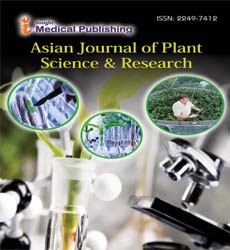ISSN : 2249 - 7412
Asian Journal of Plant Science & Research
Plants on Possibly Gainful Plant-Related Microscopic Organisms
Richardson Kelvin*
Department of Biology, University of Rostock, Rostock, Germany
Corresponding Author: Richardson Kelvin
Department of Biology, University of Rostock, Rostock, Germany
E-mail: Kelvin_R@med.de
Received date: March 07, 2022, Manuscript No. AJPSKY-22-13375; Editor assigned date: March 09, 2022, PreQC No. AJPSKY-22-13375(PQ); Reviewed date: March 18, 2022, QC No. AJPSKY-22-13375; Revised date: March 28, 2022, Manuscript No. AJPSKY-22-13375 (R); Published date: April 04, 2022, DOI: 10.36648/2249-7412.12.3.011.
Citation::Kelvin R (2022) Plants on Possibly Gainful Plant-Related Microscopic Organisms. Asian J Plant Sci Res Vol.12 No.3: 011.
Description
Finding of plant illness is to recognize the sickness nature and to decide the causal specialist whether living or non-living diagnosis of plant disease. The manifestations which show up on plants might be a result of biotic elements. Control measures rely upon appropriate distinguishing proof of infections and of the causal specialists. In this way, finding is one of the main parts of a plant pathologist's preparation. Without appropriate ID of the illness and the infection causing specialist, infectious prevention measures can be an exercise in futility and cash and can prompt further plant misfortunes. Appropriate infection conclusion is consequently essential. Knowing the personality of the plant species impacted permits the pathologist to use different assets that contain arrangements of plant infections related with explicit plants. When you select the plant of interest, you will see a rundown of bacterial, contagious, nematode, parasitic plants and viral sicknesses related with the particular plant. Sometimes these arrangements of plant sicknesses might recommend potential infection prospects or they might lead the diagnostician to preclude different illnesses. One element to remember, notwithstanding, is that these rundowns are frequently fragmented or the sickness might be new and unreported on the plant or in a particular district. The most ideal choice is to use a few distinct assets since one might not have a total list of likely sicknesses on a particular plant. Microorganisms like microscopic organisms, growths, nematodes, infections and Phytoplasmas too as abiotic issues, can all cause plant illnesses.
Distinguishing Proof of Infections and of the Causal Specialists
Abiotic issues are brought about by antagonistic limits in the climate, for example, supplement inadequacy, delayed water pressure, and air contamination. Plant pathologists adopt various strategies to diagnosing plant sickness issues. The initial step is to conclude whether the issue is a plant infection. The broadest meaning of plant sickness incorporates whatever unfavorably influences plant wellbeing. This definition can incorporate such factors as supplement inadequacies, lawnmower harm, air contamination, and microbes. A stricter definition as a rule incorporates a persevering bothering bringing about plant harm. This avoids mechanical harm, for example, lawnmower injury to trees or normal occasions like hail or lightning. An exceptionally severe definition incorporates just those (living) things that repeat themselves and spread to neighboring plants. This incorporates such natural organic entities as nematodes, growths, microorganisms, and infections. Plants harmed by perceptible living beings, like deer, rodents and birds as a rule are not viewed as sick. Underdevelopment of tissues or organs: Examples incorporate such side effects as hindering of plants, abbreviated internodes, deficient advancement of roots and contortion of leaves, insufficient creation of chlorophyll and different colors and disappointment of leafy foods to create. Overdevelopment of tissues or organs. Examples include: Nerves on roots, stems or leaves, witches' brushes and lavish blooming.
Root or passing of plant parts. These might be the absolute most observable side effects, particularly when they influence the whole plant, like shrinks or diebacks. Different models incorporate shoot or leaf scourges, leaf spots and natural product spoils. Adjustment of ordinary appearance. Examples remember mosaic examples of light and dull green for leaves, and changed hue in leaves and blossoms.
Varieties in indications communicated by sick plants might prompt an inappropriate determination. These varieties can result from two or three elements. It is conceivable that there is more than one issue present, and now and again there might be more than one microbe contaminating a plant. Side effects related with these tainted plants might be altogether not the same as the manifestations communicated in light of every one of the various microorganisms acting independently. The illness manifestations displayed by numerous microbes tainting a plant might be either more serious or less extreme than if the plant were contaminated with only one of the microorganisms. A sign of plant disease is physical evidence of the pathogen. For example, fungal fruiting bodies are a sign of disease. When you look at powdery mildew on a lilac leaf you’re actually looking at the parasitic fungal disease organism itself (Microsphaera alni). Bacterial canker of stone fruits causes gummosis, a bacterial exudate emerging from the cankers. The thick, liquid exudate is primarily composed of bacteria and is a sign of the disease, although the canker itself is composed of plant tissue and is a symptom.
Plants Might Prompt an Inappropriate Determination
A symptom of plant disease is a visible effect of disease on the plant. Symptoms may include a detectable change in color, shape or function of the plant as it responds to the pathogen. Leaf wilting is a typical symptom of verticilium wilt, caused by the fungal plant pathogens Verticillium albo-atrum and Verticillium dahliae. Common bacterial blight symptoms include brown, necrotic lesions surrounded by a bright yellow halo at the leaf margin or interior of the leaf on bean plants. You are not actually seeing the disease pathogen, but rather a symptom that is being caused by the pathogen.
It is in this manner suggested that guidelines be evaluated and updated as important to agree with global principles and in any case to figure out what is suitable for every assortment. The broadest meaning of plant sickness incorporates whatever unfavorably influences plant wellbeing. This definition can incorporate such factors as supplement inadequacies, lawnmower harm, air contamination, and microbes. A stricter definition as a rule incorporates a persevering bothering bringing about plant harm. This avoids mechanical harm, for example, lawnmower injury to trees or normal occasions like hail or lightning. Concerning official labs, the draft seed regulation says this segment considers Ethiopia's present seed testing limit while as yet requiring the possible reception of ISTA systems .In the new draft regulation the minister provides the ability to authorize and give rules, methods and principles for both focal and provincial labs to advance steady seed quality among areas. This will work with the interaction regional development of seed and in any case make an intelligent seed framework in Ethiopia. Sometimes these arrangements of plant sicknesses might recommend potential infection prospects or they might lead the diagnostician to preclude different illnesses. The personality of the plant species impacted permits the pathologist to use different assets that contain arrangements of plant infections related with explicit plants.

Open Access Journals
- Aquaculture & Veterinary Science
- Chemistry & Chemical Sciences
- Clinical Sciences
- Engineering
- General Science
- Genetics & Molecular Biology
- Health Care & Nursing
- Immunology & Microbiology
- Materials Science
- Mathematics & Physics
- Medical Sciences
- Neurology & Psychiatry
- Oncology & Cancer Science
- Pharmaceutical Sciences
